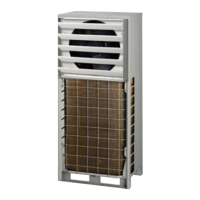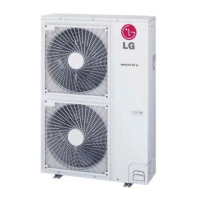36
MULTI V Space II Installation Manual
Due to our policy of continuous product innovation, some specifications may change without notification.
©LG Electronics U.S.A., Inc., Englewood Cliffs, NJ. All rights reserved. “LG” is a registered trademark of LG Corp.
REFRIGERANT PIPING CONNECTIONS
First set the DIP switches to Vacuum Mode (see page 35). Then, perform the leak test by pressurizing nitrogen gas to 550 psi on both the
liquid and gas pipes. Test with the piping service valves closed. If the pressure does not drop for twenty-four (24) hours, the system passes
the test. If the pressure drops, there is a nitrogen leak in the system. Find the leak, repair, and then test again.
To prevent the nitrogen from entering the refrigeration system in the liquid state, the cylinder must be used in a standing vertical position.
Nitrogen Gas
Cylinder
Liquid Pipe
Gas Pipe
Leak Test
Figure 37: Leak Test Diagram.
The indoor units must be OFF, and the DIP switches must be set to Vacuum Mode (see page 35) before initializing the leak test.
Leak Test
Leak Test Ambient Temperature Correction
If the ambient temperature changed between the time when pressure was applied and when the pressure drop was checked, adjust results
by factoring in approximately 1.45 psi for each 2°F of temperature difference.
Correction formula = (Ambient temperature when pressure was applied - Ambient temperature when pressure drop was checked) x 0.01.
Example:
When pressure (550 psig) was applied, the ambient temperature was 80.6°F; 24 hours later when pressure drop (540 psi) was checked,
ambient temperature was 68°F.
Thus, 80.6 - 68 x 0.01 = 0.126. In this case, the pressure drop of 0.126 was due to temperature difference, therefore, there is no leak in the
refrigerant piping system.

